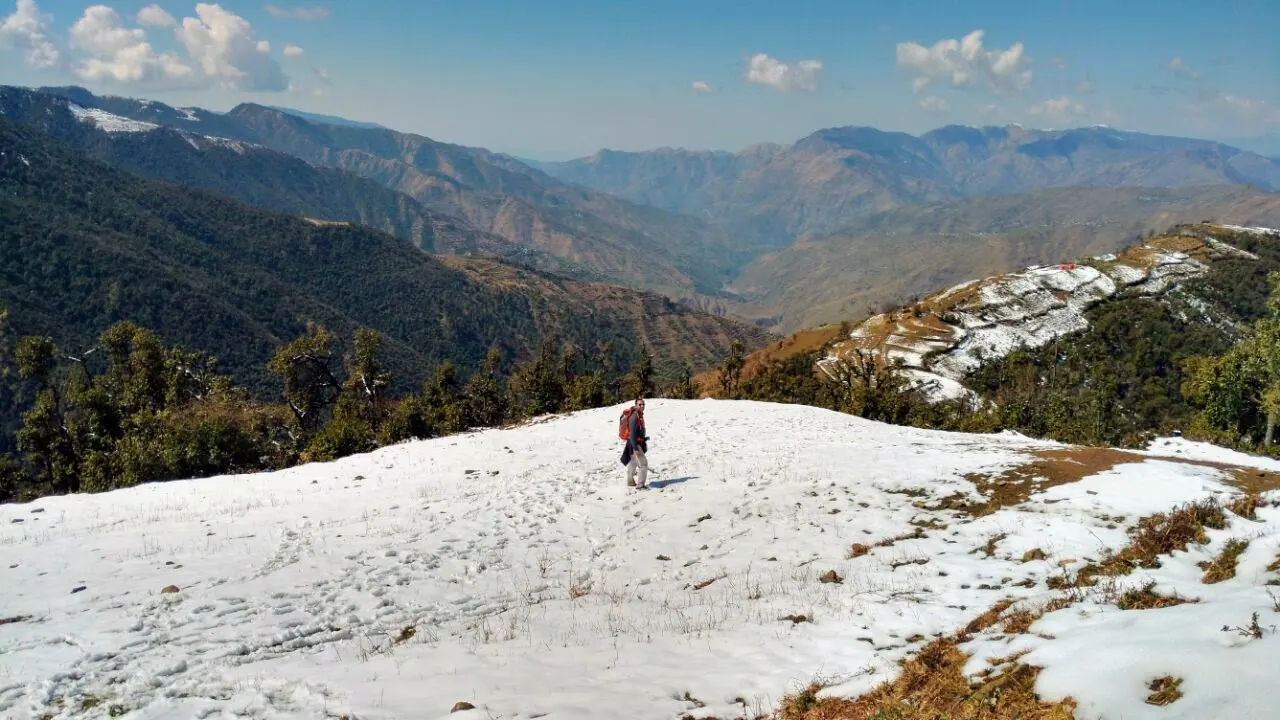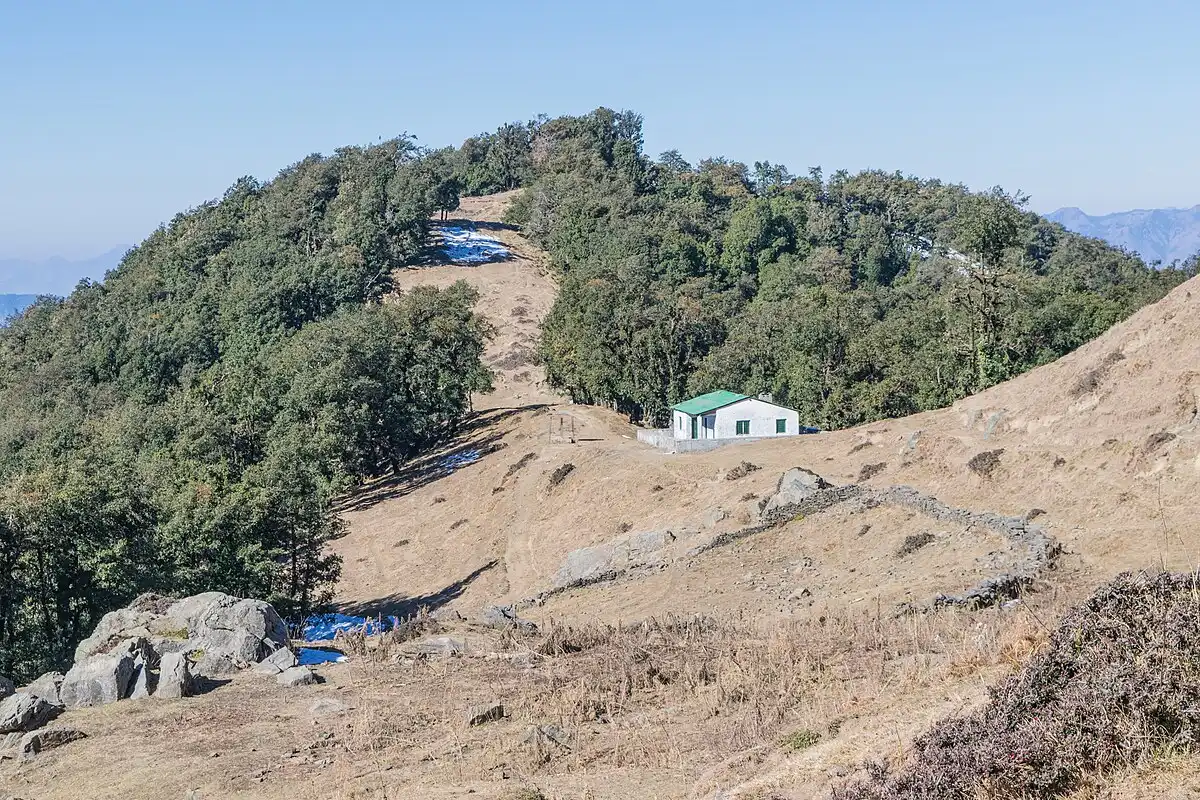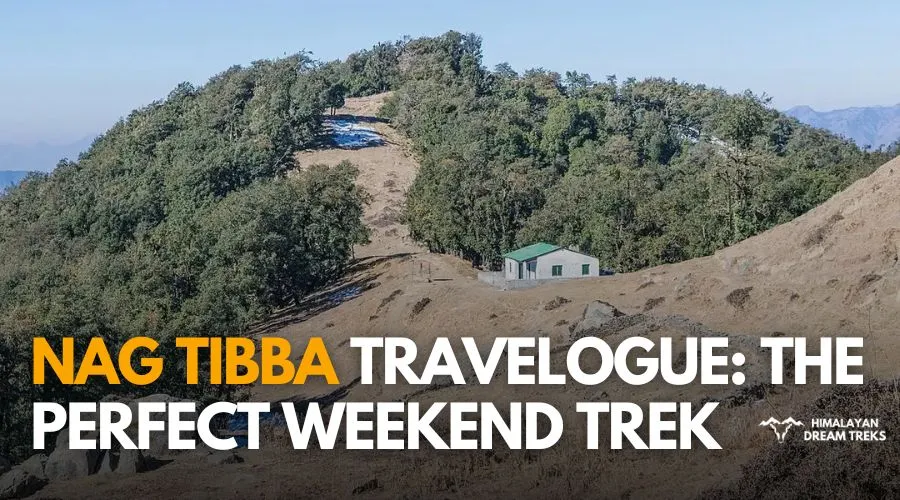Are you also feeling drained by the grind of daily life? Constantly caught in the cycle of work, meetings, and deadlines? It’s time to press the pause button. Because sometimes, all we need is a breath of fresh mountain air to reset your mind and soul. And for that, there is nothing better than heading into the Himalayas.
Don’t have the time for an extended trek? You can start with a short as well as rewarding 2-day trek to Nag Tibba like the way we did. It is located in the foothills of the Garhwal region in Uttarakhand. The name “Nag Tibba” pays homage to the serpent deity that is believed to protect the surrounding mountains.

Standing tall at an altitude of 3,022 meters (9,915 feet), Nag Tibba offers panoramic views of some of the most iconic peaks of the Indian Himalayas, including Swargarohini, Bandarpunch, Black Peak, and even the distant Gangotri Range.
No matter whether you are a frequent trekker or just a beginner, this Uttarakhand Trek offers something for everyone: fresh air, amazing vistas, and a journey that’s both spiritual and enjoyable.
Highlights of Nag Tibba Trek
- Trek Distance: 20 Km
- Trek Altitude: 9915 ft
- Base Camp: Pantwari
- Trek Difficulty: Easy
- Duration: 2 Days
- Best Time To Visit: All Year Around
- Suitable For: Both Beginners and Experienced Trekkers
Our Nag Tibba Trek Story
I have always believed that life’s greatest adventures often begin with a simple idea. For me, that idea came in the winter of 2024 when I decided to go on a trek to Nag Tibba. The cherry on top was that I wasn’t doing it alone, I had my good friend Abhishek by my side. We have shared countless memories over the years, but this one would certainly be one for the books.
It all started on a Friday night, February 2, 2024, when Abhishek and I boarded the Nanda Devi Express from New Delhi to Dehradun. The train ride, though long at 6 hours, was surprisingly comfortable. We spent the time chatting, laughing, sleeping , and mentally preparing for the weekend ahead. By the time we reached Dehradun at around 6:00 am on Saturday, we were both feeling that perfect mix of excitement and exhaustion.
After grabbing a quick cup of tea at a local stall, we headed straight to our rooms for some much-needed rest. The trek was set to begin the next morning, and we wanted to be well-rested for the adventure ahead.
The Nag Tibba Trek starts from Pantwari village, which is located about 90 km from Dehradun. We woke up after a bit of rest on Saturday, February 3, 2024, and at around 8:00 AM, we hopped into a shared jeep and started a 2-hour ride full of excitement.
As we drove through Mussoorie, the sun had just begun to rise, casting a golden glow on the Doon Valley below us. The roads were relatively quiet, with only a few locals out and about. The icy patches on the roads from the previous night’s snowfall made the ride feel even more scenic. By 9:00 AM, we crossed the famous Kempty Falls. Yes, it is now slightly commercialized but still holds the natural charm. We stopped there for pictures of the winter line, and then we continued our way through the winding mountain roads.

Our next stop came at the Yamuna Bridge, where we crossed to the other side of the valley. Seeing the river in its crystal-clear condition and sparkling form here reminded me of how we have let the waters in Delhi become polluted over the years. But there was little time to ponder that because the mountain roads ahead were calling us.
The road began to ascend, and we started whispering about our wish of riding the bike on these smooth, wavy, winding paths rather than being crammed into a jeep. The excitement was palpable, and Abhishek and I were chatting non-stop about the trek ahead.
By the time we reached Nainbagh, which is only 15 km from Pantwari, the road had become more narrow, rough, and broken. And, the lack of proper roads took us almost an hour of bumpy driving to finally arrive at Pantwari village around 12:30 PM.

But the village views made the broken way really worth it. It was peaceful and picturesque, with the locals enjoying the sunbath in the chilly winters. Then, after a quick breakfast of omelette and bread, we got our camping gear loaded on our backs and started our trek at around 1:00 PM.
The trail started behind the village, and it didn’t take long for us to realize how beautiful the landscape around us was. The climb was gradual but steady, with patches of snow from the previous night still visible on the slopes. We passed a few villagers carrying firewood, and we occasionally stopped to appreciate the view of the beautiful place they are living in.
As we moved forward, the Dhauladhar Range became visible in the distance. And that added a sense of beauty to the trek. After a short rest near a lone hut where a farmer was plowing his fields, we had the option to take two different routes, one was shorter but steeper, and the other more gradual but longer. We chose the latter, not wanting to overexert ourselves on the first day.

After about 3 hours of trekking with lots of snack and power breaks, we finally arrived at our campsite. The small hut at the site was converted into our kitchen, and we pitched our tents between a beautiful view of the snow-covered peaks surrounding us. It was the only thing we were actually there for.
We had a short rest before setting out again to reach the Nag Tibba Base, which was about 2 km from our campsite. The time was already around 5:00 PM, and the setting sun made the air noticeably colder.
After a tea break, we trekked up towards the base, the temperature continued to drop. The snow became thicker underfoot, and the wind howled around us. But we were determined to get to the base before nightfall. By 6:00 PM, we reached the Nag Tibba Base, which was covered in patches of snow. We can see and capture the Swargarohini, Bandarpunch, Black Peak views.
The summit trail was visible, but with the evening chill setting in, we decided to turn back.
The descent was quicker, and we were back at our campsite by 6:30 PM. The bonfire was already lit, and we spent the evening chatting around the warmth of the fire battling the cold mountain air.
After a long chit-chat session, dinner that night was simple yet satisfying. As we ate, locals shared stories of the region while we gazed at the starry sky. With a clear moonless night, we could see the Milky Way stretching across the heavens.
It was literally one of those rare, magical moments where time seemed to stand still. I tried to take a few pictures of the sky, but nothing could truly capture the beauty of that view.
Around 9:00 PM, it was time to head to our tents for the restful sleep. Despite the freezing temperatures, I quickly got into my cozy sleeping bag and drifted off to sleep (with the memories of the day playing in my mind and in my phone’s gallery as well).
The next morning, we woke up early, around 7:00 AM to enjoy the amazing morning views, and had a quick breakfast of oats and paranthas. We packed up our campsite, and by 8:30 AM, we began our descent back to Pantwari.

The walk back to the village was easier, and we had a great time, reaching the midway hut by around 10:30 AM. Then, by 11:30 AM, we were back in Pantwari. It felt bittersweet to leave the mountains behind, as we couldn’t shake the feeling that we were leaving a quieter world just to get back to daily hectic schedules. But the memories we’d made were worth every step of the trek.
We hopped into the shared jeep and began our bumpy ride back to Dehradun with the discussion about trek and watching each other’s photos. Then, by 2:30 PM, we were back in Dehradun, where we had a quick meal before making our way back to Delhi.
As I sit here now, reflecting on the trek, I realize it wasn’t just about the physical challenge or the incredible scenery; rather , it was about the connection I felt with nature and with Abhishek, and the peacefulness that comes with being in the mountains.
If you are looking for an adventure that combines wonderful landscapes, peace, and a bit of a challenge, I highly recommend the Nag Tibba Trek.
Sometimes, it’s these simple adventures that leave the deepest impressions. So, just convince your friend, pack warm clothes, and let the mountains do the rest.

Leave a Comment